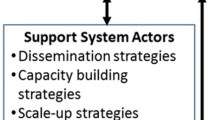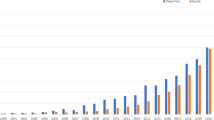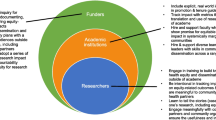Abstract
Public health is currently faced with an array of critical challenges and disconnects. Research and evaluation have identified a number of evidence-based strategies for effecting behavior change at individual, group, organizational, and environmental levels, all of which hold promise for leading to substantial reductions in morbidity and mortality, and increased quality of life. Unfortunately, there is huge variability across the public health system in awareness of the value of using evidence to inform decision making, let alone in capacity to locate, assess, compare, select, justify, adapt, implement, and evaluate evidence-based strategies, or to participate in building the evidence base for practice-based innovations. As a result, many communities may not be benefitting from research-tested and practice-based strategies that could help them to meet their public health goals more efficiently and effectively. CDC’s Interactive Systems Framework for Dissemination and Implementation (ISF), released in 2008, was designed to help close this gap between research and practice. This commentary identifies the ways in which the ISF framework is useful in addressing the research practice gap; revisits the elements of the framework that have continued to guide research and practice in fruitful ways; and highlights areas that need further development to meet current public health challenges.
Similar content being viewed by others
References
Althabe, F., Buekens, P., Bergel, E., Belizán, J. M., Campbell, M. K., Moss, N., et al. (2008). A behavioral intervention to improve obstetrical care. The New England Journal of Medicine, 358, 1929–1940.
Best, A., Stokols, D., Green, L., Leischow, S., Holmes, B., & Bucholtz, K. (2003). An integrative framework for community partnering to translate theory into effective health promotion strategy. American Journal of Health Promotion, 28, 168–176.
Cargo, M., & Mercer, S. L. (2008). The value and challenges of participatory research: Strengthening its practice. Annual Review of Public Health, 29, 325–350.
Centers for Disease Control and Prevention. (2012a). Calls to quit-line hit record high after CDC national tobacco ad campaign launch. [Press Release, April 2, 2012] http://www.cdc.gov/media/releases/2012/p0402_quitline.html. Accessed 9 May 2012.
Centers for Disease Control and Prevention. (2012b). Communities putting prevention to work. http://www.cdc.gov/healthycommunitiesprogram/communities/cppw/. Accessed 9 May 2012.
Centers for Disease Control and Prevention. (2012c). Community Transformation Grants. http://www.cdc.gov/communitytransformation/. Accessed 9 May 2012.
Centers for Disease Control and Prevention. (2012d). National public health improvement initiative. http://www.cdc.gov/stltpublichealth/nphii/index.html. Accessed 9 May 2012.
Dearing, J. W., & Kreuter, M. W. (2010). Designing for diffusion of cancer control interventions. Patient Education and Counseling, 81S, 100–110.
Escoffery, C., Carlvalho, M., & Kegler, M.C. (in press). Evaluation of the prevention programs that work curriculum to teach use of public health evidence to community practitioners. Health Promotion Practice.
Federal Register. (2002). Centers for Disease Control and Prevention. Community-Based participatory prevention research; Notice of availability of funds. Federal Register. (Thursday, February 21, 2002). 67(35):8020-8024. [FR Doc No: 02-4110] http://www.gpo.gov/fdsys/pkg/FR-2002-02-21/html/02-4110.htm. Accessed 9 May 2012.
Flay BR, Biglan A, Boruch RF, Castro FG, Gottfredson D, Kellam S, et al. (2005). Standards of evidence: Criteria for efficacy effectiveness and dissemination. Prevention Science. doi:10.10007/s11121-005-5553-y. Accessed.
Frieden, T. R. (2010). A framework for public health action: The health impact pyramid. American Journal of Public Health, 100, 590–595.
Glasgow, R. E., Marcus, A. C., Bull, S. S., & Wilson, K. M. (2004). Disseminating effective cancer screening interventions. Cancer, 101(S5), 1239–1250.
Green, L. W., Orleans, C. T., Ottoson, J. M., Cameron, R., Pierce, J. P., & Bettinghaus, E. P. (2006). Inferring strategies for disseminating physical activity policies, programs, and practices from the successes of tobacco control. American Journal of Preventive Medicine, 31, S66–S81.
Huhman, M. E., Potter, L. D., Duke, J. C., Judkins, D. R., Heitzler, C. D., & Wong, F. L. (2007). Evaluation of a national physical activity intervention for children: Verb campaign, 2002–2004. American Journal of Preventive Medicine, 32, 38–43.
Israel, B., Schulz, A., Parker, E., & Becker, A. (1998). A review of community-based research: Assessing partnership approaches to improve public health. Annual Review of Public Health, 19, 173–202.
Kaplan, R. M., & Bush, J. W. (1982). Health-related quality of life measurement for evaluation research and policy analysis. Health Psychology, 1, 61–80.
Kelly, J. A., Murphy, D. A., Sikkema, K. J., McAuliffe, T. L., Roffman, R. A., Solomon, L. J., et al. (1997). Randomized, controlled community-level HIV prevention intervention for sexual risk behavior among homosexual men in U.S. cities. The Lancet, 350, 1500–1505.
Kerner, J., & Hall, K. (2009). Research dissemination and diffusion: Translation within science and society. Research on Social Work Practice, 19, 519–530.
Kreuter, M. W., & Bernhardt, J. M. (2009). Reframing the dissemination challenge: A marketing and distribution perspective. American Journal of Public Health, 99, 2123–2127.
Lomas, J. (1993). Diffusion, dissemination and implementation: Who should do what? Annals of New York Academy of Science, 31(703), 226–235.
Maibach, E. W., Van Duyn, M. A. S., & Bloodgood, B. (2006). A marketing perspective on disseminating evidence-based approaches to disease prevention and health promotion. Preventing Chronic Disease, 3, 1–11.
Mercer, S. L., & Green, L. W. (2008). Federal funding and support for participatory research in public health and health care. In M. Minkler & N. Wallerstein (Eds.), Community-based participatory research for health: From process to outcomes (2nd ed.). San Francisco: Jossey-Bass.
Mercer, S. L., Sleet, D. A., Elder, R. W., Cole, K. H., Shults, R. A., & Nichols, J. L. (2010). Translating evidence into policy: Lessons learned from the case of lowering the legal blood alcohol limit for drivers. Annals of Epidemiology, 20, 412–420.
National Association of County and City Health Officials. (2011) More than half of local health departments cut services in first half of 2011. Press Release, October 4, 2011. http://www.naccho.org/press/releases/100411.cfm. Accessed 9 May 2012.
National Cancer Institute. (2008). The role of the media in promoting and reducing tobacco use. Tobacco control monograph no. 19. Bethesda, MD: U.S. Department of Health and Human Services, National Institutes of Health, National Cancer Institute. NIH Pub. No. 07-6242, June 2008.
Noonan, R. K., & Emshoff, J. G. (2013). Translating research to practice: Putting “what works” to work. In DiClemente, Salazar, & Crosby (Eds.), Health behavior theory for public health (pp. 309–334). Burlington: Jones and Bartlett.
Rogers, E. M. (1962). Diffusion of innovations. New York (NY): Free Press.
Valente, T. W., & Davis, R. L. (1999). Accelerating the diffusion of innovations using opinion leaders. The Annals, 566, 55–67.
Wandersman, A., Duffy, J., Flaspohler, P., Noonan, R. K., Lubell, K., Stillman, L., et al. (2008). Bridiging the gap between prevention research and practice: The interactive systems framework for dissemination and implementation. American Journal of Community Psychology, 41(3–4), 171–181.
Weisz, G., Cambrosio, A., Keating, P., Knaapen, L., Schlich, T., & Tournay, V. J. (2007). The emergence of clinical practice guidelines. Milbank Quarterly, 85, 691–727.
Wilson, K., & Fridinger, F. (2008). Focusing on public health: A different look at translating research to practice. Journal of Women’s Health, 17, 173–179.
Wilson, K. M., Brady, T. J., & Lesesne, C., on behalf of the NCCDPHP Work Group on Translation. (2011). An organizing framework for translation in public health: The Knowledge to Action Framework. Preventing Chronic Disease; March 8(2). http://www.cdc.gov/pcd/issues/2011/mar/10_0012.htm. Accessed 7 May 2012.
Author information
Authors and Affiliations
Corresponding author
Additional information
The findings and conclusions in this commentary are those of the authors and do not necessarily represent the official position of the Centers for Disease Control and Prevention.
Rights and permissions
About this article
Cite this article
Noonan, R.K., Wilson, K.M. & Mercer, S.L. Navigating the Road Ahead: Public Health Challenges and the Interactive Systems Framework for Dissemination and Implementation. Am J Community Psychol 50, 572–580 (2012). https://doi.org/10.1007/s10464-012-9534-6
Published:
Issue Date:
DOI: https://doi.org/10.1007/s10464-012-9534-6




